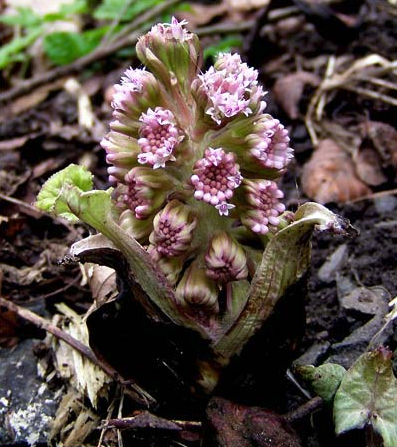Common Names: butterbur, petasites, purple butterbur. There are also several standardized butterbur extracts, such as Petadolex.
Background
- Butterbur is a shrub that grows in Europe and parts of Asia and North America, typically in wet, marshy ground. The name, butterbur, is attributed to the traditional use of its large leaves to wrap butter in warm weather.
- In the Middle Ages, butterbur was used for plague and fever, and in the 17th century it was used to treat cough, asthma, and skin wounds. More recently, it has been used for urinary tract symptoms, stomach upset, headaches including migraines, allergic rhinitis (hay fever), and other conditions.
- Commercial butterbur products that contain extracts from the root, rhizome (underground stem), or leaves of the plant are available. Raw, unprocessed butterbur products, such as teas, should not be used because they contain harmful substances.
How Much Do We Know?
- There have been a few studies of butterbur for migraines and allergic rhinitis (hay fever) in people, so we have some knowledge of its effects on these two conditions.
What Have We Learned?
- Based on two high-quality studies, the American Academy of Neurology and the American Headache Society have endorsed the use of a butterbur extract made from underground parts of the plant, like the root or rhizome, to reduce the frequency of migraines.
- Some studies of butterbur root or leaf extracts suggest that they may be helpful for symptoms of hay fever (allergic rhinitis).
- Butterbur has not been proven to be helpful for allergic skin reactions or asthma.
What Do We Know About Safety?
- The raw, unprocessed butterbur plant contains chemicals called pyrrolizidine alkaloids (PAs). PAs can cause liver damage and can result in serious illness. Only butterbur products that have been processed to remove PAs and are labeled or certified as PA-free should be used.
- Several studies, including a few studies of children and adolescents, have reported that PA-free butterbur products are safe and well tolerated when taken by mouth in recommended doses for up to 16 weeks. The safety of longer-term use has not been established.
- Butterbur is usually well tolerated but can cause side effects such as belching, headache, itchy eyes, diarrhea, breathing difficulties, fatigue, and drowsiness.
- Butterbur may cause allergic reactions in people who are sensitive to plants such as ragweed, chrysanthemums, marigolds, and daisies.
- Butterbur should only be given to children under the supervision of a qualified health practitioner.
Keep in Mind
- Although evidence indicates that butterbur is helpful for preventing migraines, its long-term safety has not been established. Your health care provider may be able to help you evaluate the potential benefits and risks of taking butterbur.
- Tell all your health care providers about any complementary or integrative health approaches you use. Give them a full picture of what you do to manage your health. This will help ensure coordinated and safe care.
For More Information
NCCIH Clearinghouse
The NCCIH Clearinghouse provides information on NCCIH and complementary and integrative health approaches, including publications and searches of Federal databases of scientific and medical literature. The Clearinghouse does not provide medical advice, treatment recommendations, or referrals to practitioners.
PubMed®
A service of the National Library of Medicine, PubMed® contains publication information and (in most cases) brief summaries of articles from scientific and medical journals. For guidance from NCCIH on using PubMed, see How To Find Information About Complementary Health Approaches on PubMed.
Office of Dietary Supplements (ODS), National Institutes of Health (NIH)
ODS seeks to strengthen knowledge and understanding of dietary supplements by evaluating scientific information, supporting research, sharing research results, and educating the public. Its resources include publications (such as Dietary Supplements: What You Need to Know), fact sheets on a variety of specific supplement ingredients and products (such as vitamin D and multivitamin/mineral supplements), and the PubMed Dietary Supplement Subset
Key References
- Butterbur. Natural Medicines Web site. Accessed at naturalmedicines.therapeuticresearch.com/ on April 1, 2015. [Database subscription].
- The Commission E Monographs: petasites root. American Botanical Council Web site. Accessed at cms.herbalgram.org/commissione/HerbIndex/approvedherbs.html on November 24, 2014. [Member subscription].
- Guo R, Pittler MH, Ernst E. Herbal medicines for the treatment of allergic rhinitis: a systematic review. Annals of Allergy, Asthma & Immunology. 2007;99(6):483-495.
- Holland S, Silberstein SD, Freitag F, et al. Evidence-based guideline update: NSAIDs and other complementary treatments for episodic migraine prevention in adults. Report of the Quality Standards Subcommittee of the American Academy of Neurology and the American Headache Society. Neurology. 2012;78(17):1346-1353.
- Man L-X. Complementary and alternative medicine for allergic rhinitis. Current Opinion in Otolaryngology & Head and Neck Surgery. 2009;17(3):226-231.
This publication is not copyrighted and is in the public domain. Duplication is encouraged.










+ There are no comments
Add yours